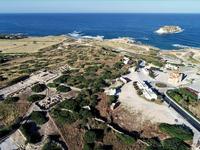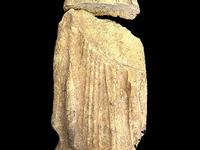Press Releases
.jpg)
20-10-2023 12:18
Announcement by the Department of Antiquities regarding the excavations at Kouklia-Marchello in 2023
The Department of Antiquities of the Deputy Ministry of Culture announces the completion of the 2023 fieldwork season at Kouklia-Marchello by the Department of History and Archaeology of the National and Kapodistrian University of Athens (NKUA). The excavation was directed by Associate Professor of Archaeology, Konstantinos Kopanias. The excavation team consisted of 17 undergraduate, postgraduate, and doctoral students and was funded by the NKUA.
Earlier excavations at Marchello have been conducted by a British (1950-55) and a Swiss-German mission (1966-73, 1985, 1992-95), as well as more recently the University of Cyprus (2006-08). These earlier investigations revealed part of the monumental, 168m-long defensive wall. Nevertheless, these investigations were incomplete and the dating of the individual building phases of the wall, as well as its overall interpretation, remains unclear.
During the 2023 season a small section of the interior NW wall was excavated. This excavation allowed the wall’s foundational layer to be documented for the first time, and the preliminary study of the pottery indicates that the wall’s earliest building phase dates to Late Cypriot IIC (13th century BC) (Fig. 1). By the end of this period, the wall fell into disuse, and some of the stones from its upper structure were reused to construct another wall located a few meters to the north. This newly-built wall likely served as an enclosure, given its crude construction and the considerable length over which it appears to have extended.
At the same time, an enigmatic structure, resembling the shape of the letter 'Π' and oriented towards the sea, was erected. Notably, two stones from this structure’s outer wall bear schematic depictions of ships that closely resemble those found at Kition, which are dated to Late Cypriot III (Fig. 2). This 'Π'-shaped structure exhibited three distinct building phases and appears to have been utilized over an extended period. The preliminary ceramic study suggests that both the enclosure and the 'Π'-shaped structure date to Late Cypriot III (12th-11th century BC). However, definitive conclusions will only be possible after a comprehensive study of the pottery has been completed.
The stratigraphic analysis indicates that the site saw little to no significant use during the Cypro-Geometric period. By the end of the Cypro-Archaic/early Cypro-Classical period (late 6th/early 5th century BC), a tunnel running north-south was dug beneath the NW section of the wall. The previous excavations led by F. Maier unveiled similar tunnels across various sections of the wall. F. Maier and previous excavators proposed that these tunnels were dug during the siege of (Palae)paphos by the Persians. However, the findings from the 2022 and 2023 NKUA excavation seasons do not seem to corroborate this theory, at least not in the case of the newly discovered tunnel. The lack of significant findings precludes a conclusive interpretation of the tunnel's purpose.
Of major significance is the fact that the investigations at Kouklia-Marchelloare being carried out in close collaboration with the existing Palaepaphos Urban Landscape Project (PULP) of the University of Cyprus, under the direction of Prof. Maria Iacovou. Cooperation between the two teams contributes to the better protection and scientific promotion of the antiquities in the broader Palaepaphos region. The fourth annual NKUA excavation season at Marchello will take place in 2024. The excavators express their warm thanks to the community of Kouklia for partially covering the cost of food and offering housing for the students.
Figure 1:

Figure 2:

(AP/SCH)
Relevant Press Releases



22-11-2024 11:25
The “Royal Chapel” of Agia Aikaterini at Pyrga closed for the public




